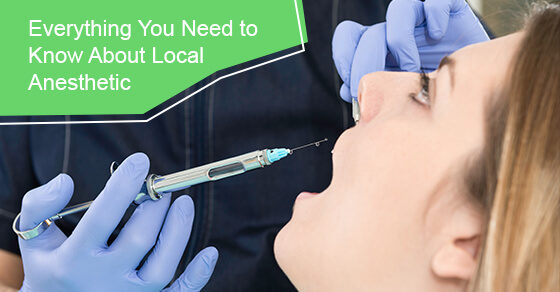Blog

Everything You Need to Know About Local Anesthetic
Posted by Dr. Julie Boudreault On 7-09-2020
Many people are surprised to learn that they will remain conscious and aware of what’s happening during a minor procedure, without any pain or discomfort. This is made possible by a local anesthetic, which works by numbing a specific area of the body.
Local anesthetics differ from general anesthetics in that you don’t lose consciousness. They are also relatively safer to use, need little preparation before use, and require much less recovery time.
Local anesthetics can be given by surgeons, dentists, doctors, or anesthetists, while some medications containing mild local anesthetics are available over-the-counter. If the idea of numbing a part of your body is uncomfortable for you, there’s no need to fear: local anesthetics are safe and commonly used.
This is your guide to local anesthetics, how they work, the benefits and risks, so you’ll be ready to go in for your procedure fully informed.
How do local anesthetics work?
When a stimulus, such as a hot object, comes in contact with your body, the nerves in that area of the body send signals to the brain. When your brain receives these signals, it triggers a reflex response to remove that area of the body away from the hot object.
Local anesthetics work by overriding this relay system. They function by stopping the nerves in the specific area of your body from sending signals to your brain. Once a local anesthetic is applied, you won’t be able to feel any pain in that specific area, although you may still be able to feel some movement or pressure.
It’s important to notify the dentist before you receive a local anesthetic if you have any open wounds near the affected area, a bleeding disorder, or are consuming any medications — these could increase your risk of bleeding.
Once the anesthetic wears off, you will regain full sensation in the previously numbed area. In some cases, local anesthetics are used in combination with other sedatives to help you relax.
A local anesthetic is only used for surgeries during which you can be awake, such as a tooth extraction. A local anesthetic may be combined with sedation for surgical extractions.
Different Types of Local Anesthetics
The type of anesthetic used is dependent on several different factors, including the length of the procedure, any underlying health conditions or medications currently being taken, and the size of the area required to be numbed.
Local anesthetics can be categorized into two main categories based on their method of administration. These include topical anesthetics and injections.
1. Topical anesthetics
Topical anesthetics are applied directly to the skin or a mucus membrane, such as the inside of your mouth, nose, or throat. It comes in several different forms, including liquids, creams, gels, patches, or sprays.
2. Injectable anesthetics
Injectable anesthetics are used as numbing agents during procedures, rather than as a form of pain management. Injection anesthetics are used to numb large areas of the body by stopping the pain signals.
Peripheral nerve blocks are local anesthetic injections used to numb the nerves that are supplying a specific part of the body, such as the gum. Injectable anesthetics are sometimes given in combination with sedatives during or after surgery as a form of pain management.
Are there any risks or side effects of local anesthetics?
Local anesthetics are generally very safe to use, and any serious side effects or problems are rare. You may experience discomfort if the anesthetic is applied through an injection, a tingling sensation as the medication begins to wear off, and possibly some minor bruising, bleeding, or soreness at the place where the injection was given.
It’s important to rest and move around with caution until the anesthetic has fully worn off to avoid injuries that you may not be able to feel or notice. Although side effects are uncommon, some individuals may experience some temporary side effects if too much anesthetic is given or if the injection reaches the vein. These side effect could include:
- Dizziness
- Muscle twitches
- Blurred vision
- Headaches
- Ringing in the ears
- Metallic taste in the mouth
- Unusual sensations (numbness, weakness, or pins and needles)
It’s important to remember that most of these side effects are temporary and will wear off as the medication wears off, however, be sure to notify your dentist about what you may be experiencing if the side effects persist.
Are there any safety concerns with local anesthetics?
Local anesthetics are a relatively safe way to numb an area before a procedure, with minimal side effects unless the dose exceeds the recommended amount. In certain unique situations, such as with pregnant women, local anesthetics should be used with caution and the type of anesthetic used, how much is administered, and the stage of the pregnancy must all be taken into consideration.
Overall, it’s usually a good idea to postpone elective procedures requiring anesthetics until after the pregnancy to avoid any harm to the developing baby. Or, discuss all options and risks with a doctor if anesthesia is required during a crucial procedure.
Surgeries and other invasive procedures can be frightening, but with the right anesthetics, you won’t feel any pain during or after the procedure. Your dentist will offer quality sedatives and anesthetics to help you remain calm, relaxed, and pain-free during dental procedures.
To learn more about local anesthetic in Toronto, call Milltown Dental at 905-878-8528 or contact us here.


Posted on 22-11-2021 by Amy Saunders
Oh now, I never would’ve thought that we can apply anesthesia on our skin as well! My cousin has been scheduled to undergo a minor surgery on his face next month and he wants to find out what kind of anesthesia is available. I’ll ask him to look further into this option when he consults with a doctor later.